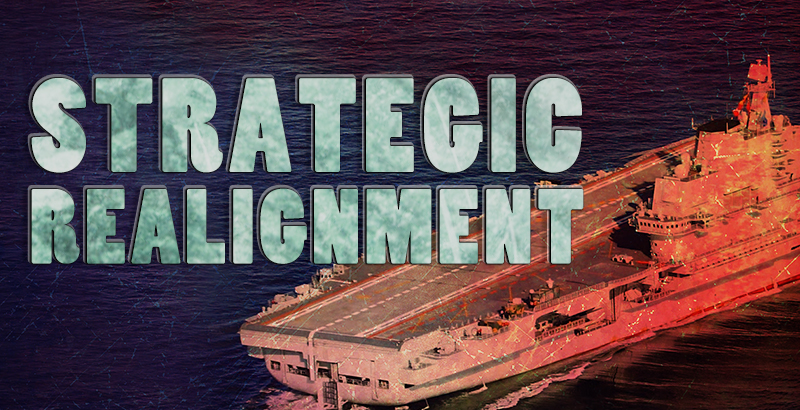
Written by Brian Kalman exclusively for SouthFront; Brian Kalman is a management professional in the marine transportation industry. He was an officer in the US Navy for eleven years. He currently resides and works in the Caribbean.
Introduction
China has begun construction of the first Type 075 Landing Helicopter Dock (LHD) at the Shanghai based Hudong Zhonghua Shipbuilding Company. Construction most likely started in January or February of this year, with some satellite imagery and digital photos appearing online of at least one pre-fabricated hull cell. The Type 075 will be the largest amphibious warfare vessel in the Peoples’ Liberation Army Navy (PLAN), with similar displacement and dimensions as the U.S. Navy Wasp Class LHD. The PLA has also made it known through non-official channels that the force plans to expand the current PLA Marine Corps from 20,000 personnel to 100,000. As China completes preparations for its new military base in Djibouti, located in the strategic Horn of Africa, it has also continued its substantial investment in developing the port of Gwadar, Pakistan. Not only will Gwadar become a key logistics hub as part of the China-Pakistan Economic Corridor (CPEC) and the “One Belt, One Road” trade initiative, but will also be a key naval base in providing security for China’s maritime trade in the region.
When these developments are viewed in conjunction with the decision by the PLA leadership to reduce the size of the army by 300,000 personnel, it is obvious that China has reassessed the strategic focus of the nation’s armed forces. The PLA Marines and Navy will be expanded in size considerably. China continues to modernize and expand the PLAN, as well as establish a foothold in the South China Sea. China has signaled its intention to fortify and man island bases in this strategically important region, as well as establish bases adjacent to the Indian Ocean and close to both the Strait of Hormuz and the Strait of Aden. The PLAN’s increasingly capable and substantial blue water navy, especially one with both powerful amphibious warfare and aircraft carrier components, will allow China to establish and maintain lines of communication between these key military bases. Although its regional neighbors may see the expansion of Chinese naval power projection capability and naval presence as a threat, it is obvious that China is making the necessary security commitments required to protect its massive investment in building a global trade and transportation network, the Silk Road Economic Belt/Maritime Silk Road Initiative.
Maritime Realignment
The South China Morning Post reported in late March that anonymous sources within the PLA and PLAN informed them that plans were underway to both expand the PLA Marine Corps, move forward with a substantial expansion of the PLAN, and to deploy these maritime forces to strategic bases within China’s maritime territories and greater maritime sphere of influence. These sources disclosed the PLAN’s intention of expanding the current force structure of the PLA Marine Corps fivefold, from two brigades (20,000 men) to ten brigades (100,000 men). They also stressed that the PLAN will be increased in size and capabilities, with many new, large displacement warships of varying types added to the fleet. Of particular interest, are the addition of at least two Type 055 DDGs, an indigenously designed and built aircraft carrier of a new class, two more Type 071 LPDs (bringing the total to six in class), and the first Type 075 LHD.
The shipyards of China continue to turn out Type 052D Class Destroyers, Type 054 Class Frigates, and Type 056 Class Corvettes at break neck speed. China is rapidly gaining the ability to project power and naval presence at increasing distances from its shores. Not only is the PLAN expanding in tonnage, but its new vessels are considerably more capable, having greater range, firepower, and next generation radar, sonar, communications and battle management systems. The PLAN will be striving to add and train an additional 25% more personnel over the next half a decade, in an effort to add the skilled crews, pilots, and support personnel that will facilitate such an ambitious expansion. In the same period of time, the PLA will shed approximately 300,000 personnel.
In a previous analysis of China’s amphibious capabilities, I detailed the planned expansion of both the PLA Marines and the doubling of the number of Amphibious Mechanized Infantry Divisions in some detail. The new information coming out of the South China Morning Post reports raise a number of questions. Does the Chinese leadership intend to expand the PLAMC by a factor of five after already doubling the number of AMIDS since 2014? If this is true, a 100% increase in the PLA AMIDs and a 500% increase in the PLAMC denotes a major strategic shift in the defense strategy of the Chinese state. With the successful growth of the Silk Road Economic Belt/Maritime Silk Road Initiative, it becomes readily apparent that China must focus on securing and defending this global economic highway. China has made a massive investment, in partnership with many nations, in ensuring the success of a massive system of economic arteries that will span half of the globe. Many of these logistics arteries will transit strategic international maritime territories. In light of these developments, a military shift in focus away from fighting a ground war in China, to a greater maritime presence and power projection capability are quite logical.
Maritime Bases in Djibouti and Gwadar
As China has taken great efforts to secure its economic prosperity well into the future, it saw fit to lay the groundwork of protecting such interests, negotiating mutually beneficial defense agreements with nations bordering the strategically important Indian Ocean. China began construction of a maritime support facility in Obock, Djibouti in 2016, to ostensibly protect its interests in Africa (with over $30 billion USD invested in that continent), facilitate joint anti-piracy operations in the region, and to provide a naval base to support long range and extended deployments of PLAN assets to protect the shipping lanes transiting the Strait of Aden. In addition, China invested approximately $46 billion USD in developing the China-Pakistan Economic Corridor, including major investment in the infrastructure of the port of Gwadar. The governments of both nations desire the stationing of a flotilla of PLAN warships in the port, and possibly a rapid reaction force of PLA Marines. Gwadar is well positioned to not only protect China’s economic interests in Pakistan, but also to react to any crisis threatening the free passage of maritime traffic through the Strait of Hormuz, chiefly energy exports bound for Chinese ports.
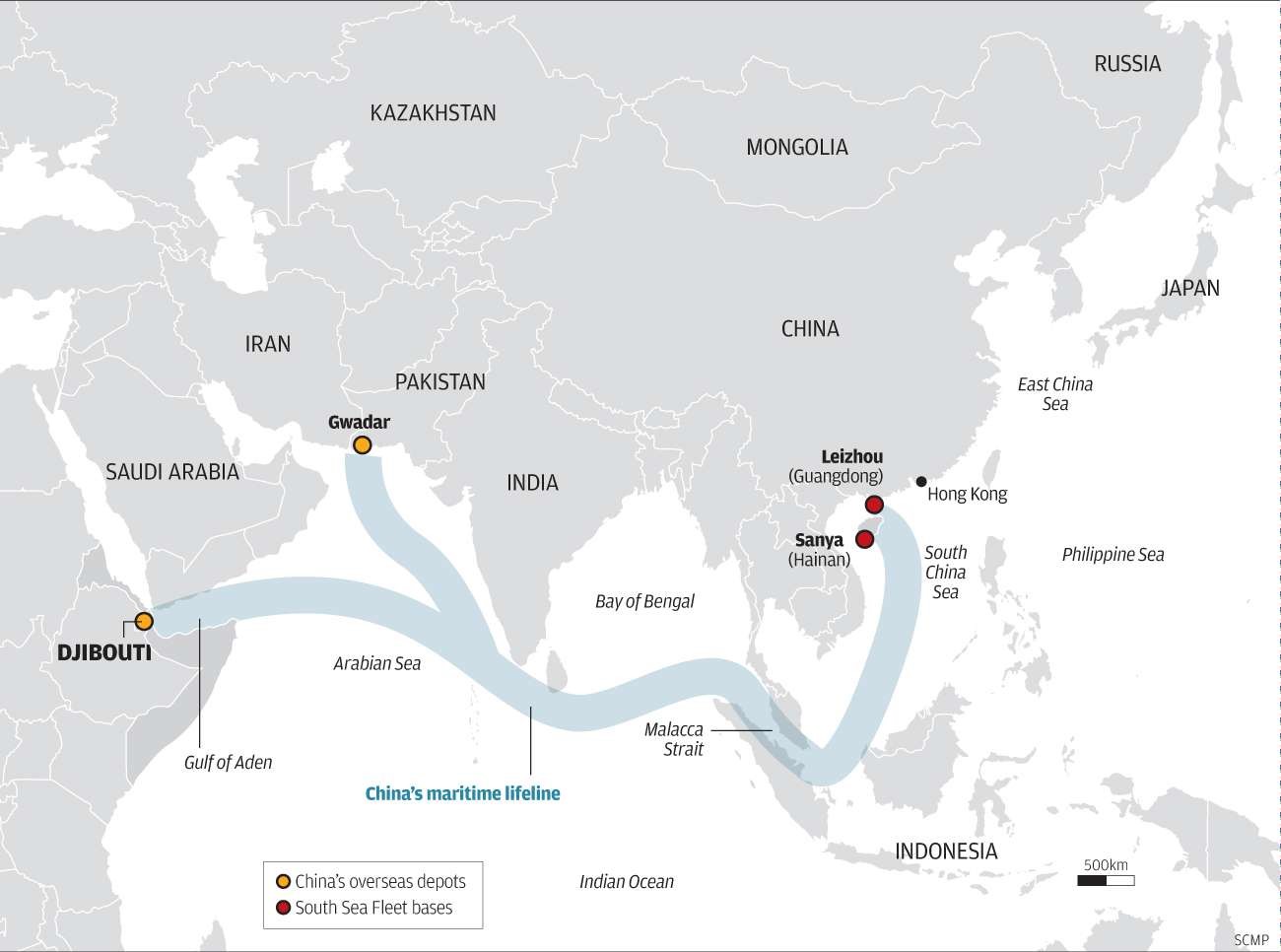
A simplified view of the PLAN maritime lines of communication between its major naval bases in southern China and its newly established oversees bases. The major island bases in the South China Sea are omitted from this map, but should be considered in gaining an accurate picture of Chinese maritime defense posture.
The military base being built in Obock, Djibouti is located very close to the U.S. military base Camp Lemonnier, as well as a much smaller facility operated by the Japanese Maritime Self Defense Force (JMSDF). Although China has downplayed the military role of the base, it is obvious that such a facility is meant to not only be able to provide resupply, refueling and maintenance for PLAN vessels, but also to support PLAN submarine patrols in the Indian Ocean, and for the prepositioning of amphibious warfare elements. The significant expansion of the PLAMC and the continued construction of new amphibious warfare vessels supports this thesis. The forward positioning of naval forces will allow the PLAN to protect the vital crude oil and natural gas imports transiting the Suez Canal (2% of the national total annually), the Gulf of Aden (4% annually) and into the Indian Ocean from routes west of the Horn of Africa (34% annually). In light of the fact that 6% of natural gas imports and 34% of crude oil imports by sea to China transit this region, the desire to secure these waterways becomes readily apparent.
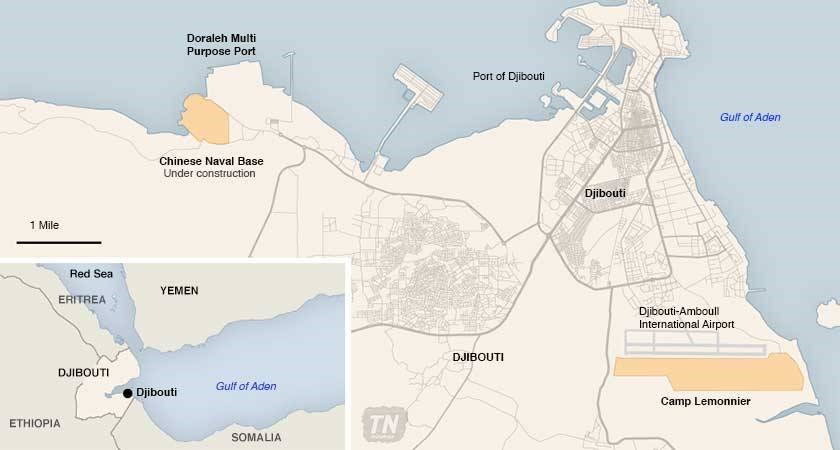
The location of the PLAN base at Obock, Djibouti in relation to U.S. Camp Lemonnier. The inset map clearly illustrates the strategic geographic location of Djibouti at the nexus of the Red Sea and the Gulf of Aden.
The strategic importance of a Gwadar naval facility on the south coast of Pakistan is also quite obvious. Not only would the presence of PLAN warships and marines help to secure China’s vital interests in Pakistan and the China-Pakistan Economic Corridor in particular, but would also afford the PLAN a base of operations close to the Strait of Hormuz. Approximately 51% of all Chinese crude oil imports by sea transit the strait, as well as 24% of seaborne natural gas imports. Any closure of the Strait of Hormuz due to a theoretical military conflict or an act of terrorism or piracy would have a huge impact on the Chinese economy. China’s joint naval exercises with warships of the Iranian Navy recently, showcase China’s willingness to work with regional powers to address the vital importance of maintaining maritime trade through this geographic choke point.
Continued Development and Fortification of Islands in the South China Sea
Although the maritime trade routes transiting the Indian Ocean are of vital importance to keeping the manufacturing engine of China running uninterrupted, the South China Sea is of even greater importance, for a number of factors. Not only does the region facilitate the passage of $5 trillion USD in global trade annually, but much of this trade is comprised of Chinese energy imports and exports of all categories of finished and manufactured goods produced in China. The geographic bottle neck of the Strait of Malacca, to the southwest of the South China Sea, affords the transit of 84% of all waterborne crude oil and 30% of natural gas imports to China. The closure of the strait, or a significant disruption of maritime traffic in the South China Sea, would have a devastating impact on the Chinese state. It is in the vital national interest of China to secure the region based on this fact alone. In addition, establishing a series of strategically located island outposts, covering the approaches to the South China Sea, affords China a greater ability to secure the entire region, establish Anti-Access/Area Denial (A2/AD) and defend the southern approaches to the Chinese mainland, while enforcing the nation’s claims to valuable energy and renewable resources in the region.
China continues to expand and reinforce its island holdings in both the Paracel and Spratly archipelagos. The massive construction on Mischief Reef, Fiery Cross Reef and Subi Reef will likely be completed later this year. These three islands represent China’s greatest investment in establishing control in the Spratly Islands and the South China Sea as a whole. All three islands possess large reinforced runways of between 2,500 and 2,700 meters in length, bomb-proof aircraft hangars, munitions bunkers, extensive housing and support facilities for personnel, and advanced radar towers and arrays. Combat aircraft and HQ-9 surface-to-air missiles have been deployed to some of the islands over the past year. These three islands, in conjunction with the surveillance stations, port facilities and helicopter bases located on a number of key smaller atolls, as well as on natural and manmade islands throughout the Spratley archipelago, afford China the capability to project power and presence in the region at a level that no other regional or global power can match. The island bases, when coupled with missile forces and combat aircraft based on mainland China, and powerful naval forces based in southern China, can effectively enforce A2/AD operations over the entire South China Sea. Strong island garrisons of PLAMC marines and PLA amphibious light infantry will be required to secure and defend these bases, and to supplement PLA and PLAN personnel tasked with the administration of the airfields, harbors and radar facilities.
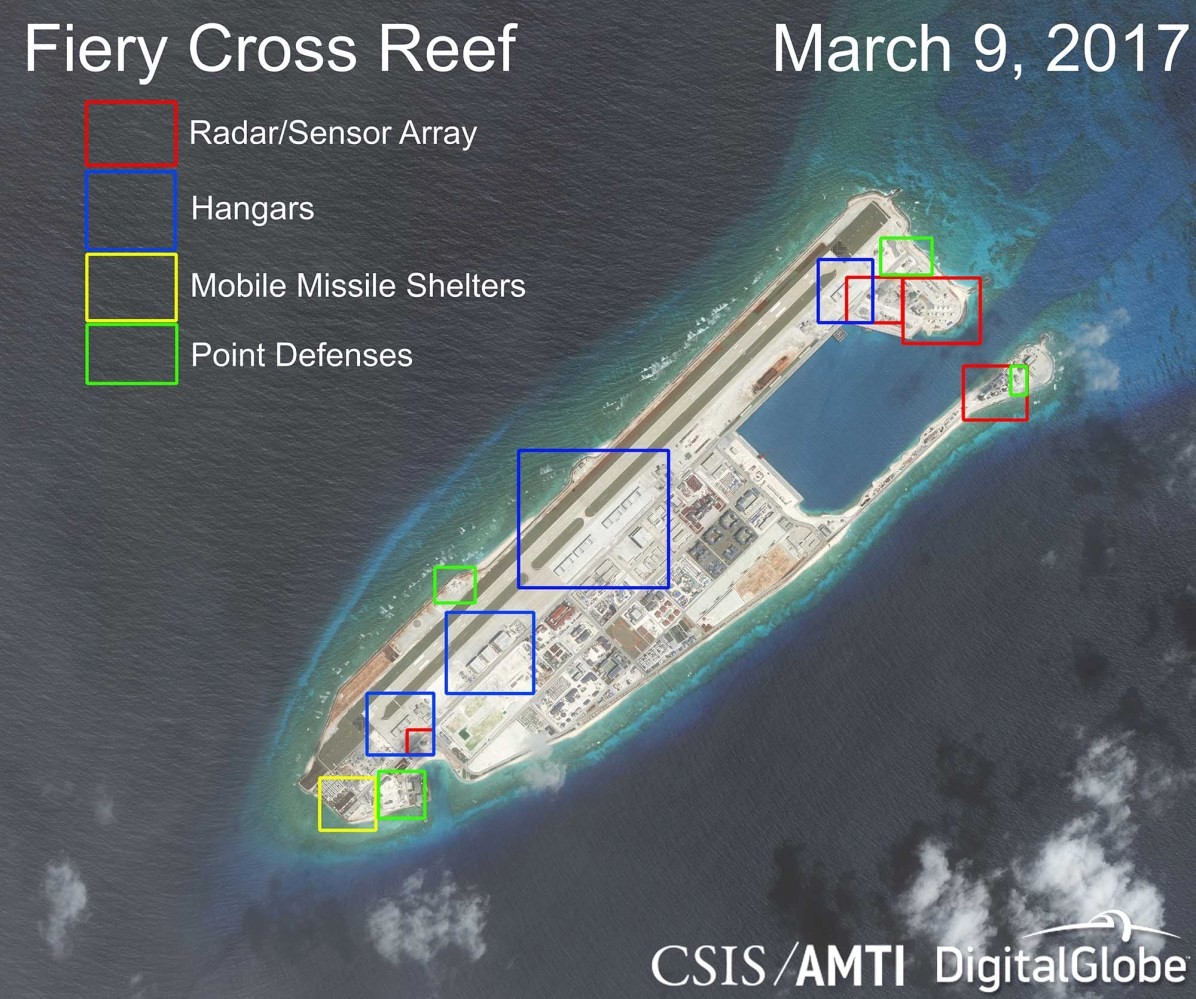
The above satellite imagery illustrates the extent of the development of Fiery Cross Reef since major land reclamation began in 2014. Fiery Cross Reef is approximately two thirds the size of Subi Reef and half the size of Mischief Reef.
China has simultaneously been reinforcing its position in the Paracel Islands. The largest island and the center of administration in the region is Woody Island; however, China has made a great deal of progress in building naval and helicopter support facilities on a number of smaller islands, most notably on Duncan and Palm Islands, and Tree Island. These islands could soon serve as naval replenishment and/or anti-submarine warfare (ASW) bases. Tensions with Vietnam over the disputed sovereignty of the Paracel Islands have continued long after China defeated Vietnamese forces in a number of naval skirmishes in the 1970s and 1980s. The discovery of oil and natural gas deposits in the region have fueled an increase in tensions between the two nations in recent years.
A Growing Amphibious Warfare Fleet
As China moves forward in expanding the PLAMC and the amphibious divisions of the PLA, it has maintained a swift schedule in shipbuilding which aims to provide a balanced and flexible amphibious sealift capability. Currently, the U.S. Navy has by far the largest and most capable amphibious assault fleet in the world. China does not aim to surpass this fleet, but to tailor a modern and sizable amphibious warfare fleet that is capable of defending the growing maritime interests of the nation, and which can provide a significant power projection capability that can be employed across the full breadth of the Maritime Silk Road. These forces must be highly flexible, of extended range and endurance, and be available in such number as to be able to cover a very large geographic area.
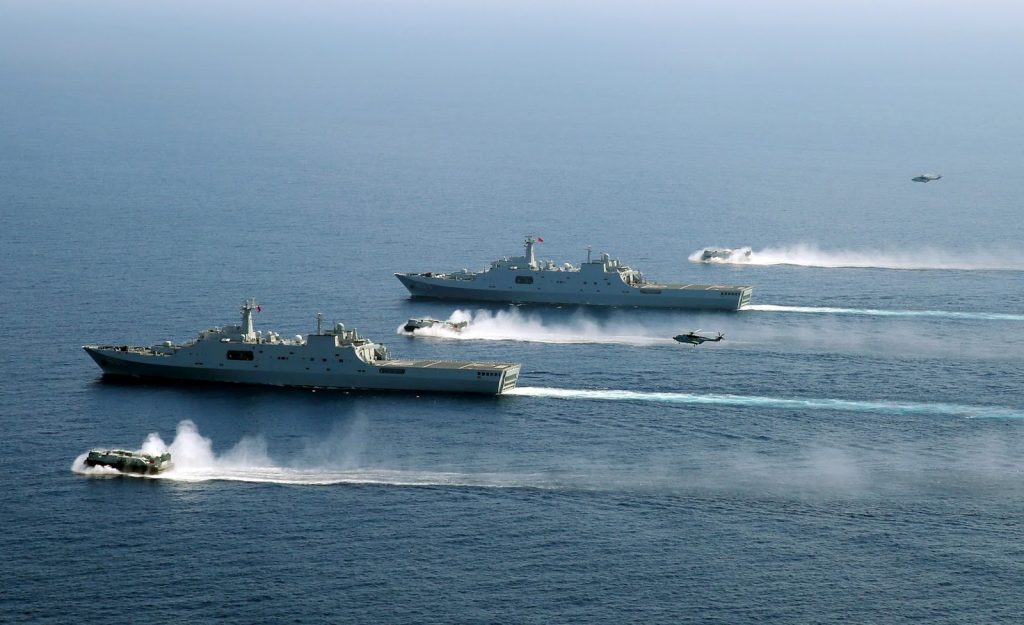
Two Type 071 LPDs conduct operations with Z-8 helicopters and Type 726A LCACs in waters off Hainan Island in the South China Sea.
The first two classes of amphibious vessels that were seen as essential to design, construct and supply to the PLAN were the Type 072A class Landing Ship Tank (LST) (the follow-on to all previous Type 072 class LSTs) and the Type 071 class Landing Platform Dock (LPD). The PLAN operates 32 Type 072 class LSTs of all variants, with 15 of these of the new Type 072A design. The Type 072A has a more streamlined superstructure, and a well deck designed to accommodate an LCAC. The vessel has a small flight deck that can accommodate one helicopter, and enough underdeck space to stow a maximum of 10 MBTs, or 500 tons worth of light vehicles and cargo. Approximately 250 to 300 troops can be accommodated.
There are a total of six Type 071 LPDs planned, with four currently in service and the fifth vessel reaching completion this year. Three out of the four vessels currently in service operate with the South Sea Fleet, and one is deployed with the East Sea Fleet. The fifth vessel in class should be ready for sea trials this summer, while the sixth and final vessel is currently under construction by the Hudong Zhonghua Shipbuilding Company. These LPDs are equipped with an aft flight deck and hangar to support helicopter operations, and a well deck to allow amphibious assaults via AAVs, landing craft or LCAC (Landing Craft Air Cushioned) hovercraft. Each vessel is equipped with a hospital, ample cargo space for the provision of disaster relief supplies and or light vehicles, and room to house a troop complement of approximately 500 to 800 troops dependent on the mission. The LPD has the inherent flexibility to provide over the horizon air assault and amphibious assault capability. These vessels are ideally suited to Humanitarian and Disaster Relief (HADR) operations in South and Southeast Asia due to their shallow draft and inherent operational flexibility.
The Type 075 Class LHD Takes Shape
In alignment with all major navies of the world, the PLAN has acknowledged the many benefits to be realized by possessing a large multi-role naval platform such as a Landing Helicopter Dock (LHD), Landing Helicopter Assault (LHA) or Landing Ship Dock (LSD). Larger is dimensions and displacement than an LPD, these vessels provide greater power projection capabilities and give naval planners a multitude of options in tackling both military and humanitarian challenges. Perhaps the most flexible of these large vessel designs is the LHD.

A number of photos of what is believed to be the first partially constructed Type 075 Class LHD have appeared online early this year. Earlier satellite imagery of a completed hull section that matches the dimensions of the above vessel circulated online at the end of 2016.
Plans to build such a vessel began in 2012, with a number of different designs contemplated. The class was known in intervening years as the Type 075 or Type 081. The final design was finalized and plans were made to begin construction in 2016. The same shipbuilder that has produced the Type 071 LPDs, the Hudong Zhonghua Shipbuilding Company, was once again relied upon to construct the first of at least two Type 075 LHDs. Although many analysts believe that the PLAN intends to build two such vessels, there will most likely be a need for one or two additional vessels of this class to meet the growing maritime security and power projection requirements of the nation. All signs point to the PLAN’s intentions of establishing two to three Amphibious Ready Groups (ARGs), as they have slowly and methodically developed a modern amphibious warfare skillset over the past two decades. They have taken a similar approach to establishing a modern carrier-based naval aviation arm. China’s successful establishment of a fledgling, yet capable aircraft carrier program in just a few decades has impressed even the most strident of sceptics.
The Type 075 Class LHD is closest in design and size to the U.S. Navy Wasp Class LHD. From what is known, the Type 075 will displace 40,000 tons, have an LOA of 250 meters, and a beam of 30 meters. The Wasp Class displaces just over 41,000 tons loaded, has an LOA of 257 meters and a beam of 32 meters. The Wasp Class flight deck measures approximately 92,000 square feet and can handle medium and heavy helicopters as well as VSTOL fighter/attack aircraft.
The Type 075 will be fitted with a large well deck, allowing for amphibious operations by LCACs, AAVs, and conventional landing craft. Each LHD could theoretically carry approximately 1,500 to 2,000 marines, a full complement of a mixture of MBTs and AAVs (approximately 25-40 armored vehicles), 60 to 80 light vehicles, and ample cargo stowage space. The helicopter compliment will most likely consist of approximately 20 Z-8 transport helicopters, two Z-18F ASW helicopters, one or two Ka-31 AEW helicopters, four Z-9 utility helicopters, and possibly 6 to 8 naval versions of the Z-10 attack helicopter. With no VSTOL fixed wing attack aircraft in service, the PLAN would most likely opt for using a rotary wing attack element for the LHDs, in a similar fashion as the Russian Navy had planned for the Mistral class vessels that France had built, yet failed to deliver, and eventually sold to Egypt.

Z-10 attack helicopters operated by the PLA. A Z-10 modified for naval use would serve a similar purpose as the U.S. Marine Corps AH-1Z Viper and Russian Ka-52k naval attack helicopters.
Diplomatic Efforts at De-escalation
While the United States, under the present and past three administrations, has attempted to influence potential adversaries with the “stick” of threatened military action, and potential allies with the “carrot” of weapons sales, Chinese diplomacy has been much more creative in achieving its aims. In its pursuit of building the Silk Road Economic Belt/21st Century Maritime Silk Road (One Road-One Belt Trade Initiative), the Chinese have negotiated mutually beneficial trade deals with a number of nations. These deals have included multi-billion dollar energy and transportation infrastructure projects which will provide significant benefits to the host nations for decades to come, and will improve the economic and social welfare of these nations immensely. In addition, joint security agreements, such as the stationing of a PLAN flotilla in Gwadar, also exhibit a willingness to share the burden of securing shared economic interests from a multitude of threats.
China has not shied away from using its military to secure what it sees as its vital economic, territorial, and energy interests in its own backyard, or even as far away as the Gulf of Aden. While building the PLAN into a credible fighting force, indeed an overpowering one to many regional neighbors, the Chinese leadership have also attempted to de-escalate regional disputes in conjunction with naval power presence operations. While clearly exhibiting resolve and determination in the impressive island building projects undertaken in the South China Sea, China has also offered incentives to regional neighbors in a multifaceted diplomatic effort. Some such efforts have been successful in de-escalating territorial disputes in the South China Sea, while others have failed to produce results.
Although far from establishing an agreement on sovereignty over the shoals or coming to a formal agreement on fishing rights, China and the Philippines have greatly de-escalated tensions over the Scarborough Shoal since both Presidents Xi Jinping and Rodrigo Duterte met earlier this year to discuss the long running dispute over the territory. It was a welcome development to see both parties sit down to bilateral discussions at the highest levels of government.
On June 20th, China and Vietnam prematurely ended bilateral military talks intended to de-escalate territory disputes over territory in the Paracel Islands. Given the long and sometime bloody history between the two nations, having fought a number of battles over both the Paracel and Spratley Islands in 1974 and 1988, not to mention a Chinese limited invasion of Vietnam in 1979, it came as quite a surprise to many political observers that both nations would attempt such a meeting. The amount of political will necessary to bring about such a meeting, in light of such a history, speaks highly of elements within both governments that desire mitigation of disputes that could possibly lead to military conflict in the near future. Apparently, the military representatives of both nations found that the nations’ differences of opinion over sovereignty and resource rights were not resolvable at this juncture. The Chinese representatives were not happy about joint Vietnamese-Japan Coast Guard exercises early in June, nor the recent official visit to the United States and Japan by the Prime Minister of Vietnam. Continued oil exploration activities in the Paracels by Vietnamese entities in partnership U.S. energy companies, also added fuel to the fire. Chinese energy exploration in the region has also increased substantially, including in areas within the 200 mile Economic Exclusivity Zone of Vietnam.

Chinese and Vietnamese Coast Guard vessels engaged in a tense standoff over the oil exploration activities of the Chinese drill rig Haiyang Shiyou 981 in the summer of 2014. The rig eventually departed the area after a groundswell of public opposition in Vietnam and Hong Kong.
Securing Economic and Maritime Territorial Interests Well Into the Future
China has been slowly and methodically building the foundations of economic and military security, and instead of offering the choice of vassalage or invasion like the United States, or a set of restrictive economic rules that only benefits the authors of the rules like the European Union, China is offering those nations that cooperate as part of the New Silk Road/Maritime Silk Road a seat at the table. In order to create a mutually beneficial trade and transportation network, one that may soon supersede or compete against others, China must secure its vital interests, backed up by military force, and build a viable and sustainable naval presence in key maritime regions.

A map of the New Silk Road. The PLAN must grow and expand in capabilities to secure the maritime segment of this ambitious trade project.
Will China be allowed to build the New Silk Road and 21st Century Maritime Silk Road without interference from global parties that see the project as a threat to their preeminence in the global economic and political power structure? As Admiral Alfred Thayer Mahan wrote, in perhaps his most influential work The Influence of Sea Power upon History 1660-1783:
“The profound influence of sea commerce upon the wealth and strength of countries was clearly seen long before the true principles which governed its growth and prosperity were detected. To secure one’s own people a disproportionate share of such benefits, every effort was made to exclude others, either by the peaceful legislative methods of monopoly or prohibitory regulations, or, when these failed, by direct violence. The clash of interests, the angry feelings roused by conflicting attempts thus to appropriate the larger share, if not the whole, of the advantages of commerce, and of distant unsettled commercial regions, led to wars.”
Will this be true in the case of China, or has China created a better model to follow? Will the United States and the European Union allow China to assume a leadership role in the world’s commerce and economic development, or will they seek to retard or even halt such a move? With the E.U. nations in a position to benefit from China’s plans, and with little or no military force available to threaten China in real terms, the United States is likely on its own in such a fight. As successive U.S. administrations have warned that China has aggressive and expansionist intentions, which it has stated are easily extrapolated by the speed and qualitative growth in that nation’s Navy, it is important to once again rely on the wisdom of A.T. Mahan:
“The necessity of a navy, in the restricted sense of the word, springs, therefore, from the existence of a peaceful shipping, and disappears with it, except in the case of a nation which has aggressive tendencies, and keeps up a navy merely as a branch of the military establishment.”
I would ask the reader, has China expanded and strengthened its navy to protect commerce, or to fuel aggressive tendencies? China represents the second largest economy in the world, is by far the largest exporter of goods, and is also the largest shipbuilder in the world. It would appear that China is conforming to A.T. Mahan’s thesis that increased ocean commerce requires an increased naval presence to safeguard such commerce. By contrast, the United States Navy is by far the largest navy in the world, and yet there is virtually no U.S. flagged merchant marine. The United States has chosen to “outsource” ocean shipping to its foreign trade partners, and has forward deployed its navy to those partners’ maritime territories. The United States ranks very low on the list of global shipbuilders, and largely only produces small coastal vessel for domestic commerce, and warships for its large navy. Has the United States proven that it has aggressive tendencies, and maintains a large navy as a component of an overarching military industrial complex? The past two decades of U.S. led war alone have proven these aggressive tendencies, and successive U. S. defense budgets, now over $600 billion annually, prove the overwhelming influence of the U.S. military industrial complex.
China has clearly signaled that its defense strategy is changing. The Chinese leadership feels that the sovereignty of mainland China is secure and is shifting focus to securing the vital maritime trade lifeline that not only ensures the security of the nation, but will allow China to increase its economic prosperity and trade partnerships with a multitude of nations. A larger and more capable PLAN is required not only to secure the maritime territories of China, including the resource rights in regional territories such as the South China Sea, but will also be required to secure and keep open the ever lengthening maritime lines of communication to interconnected points along the Maritime New Silk Road. More powerful and longer range vessels, and increased endurance and operational flexibility will all be required. A strong amphibious warfare force of trained men and women, equipped with larger and more capable vessels are an imperative. Some of these forces must be forward deployed and garrisoned at key strategic points.
Whether the United States decides to stand in the way of China’s growth or chooses to participate more constructively in a mutually beneficial relationship is yet to be determined. The official message coming out of Washington over the past decade seems to denote a coming conflict of interests. The current U.S. administration has been sending somewhat mixed and conflicting signals. Without a doubt, China has set its course and will not deviate from this course unless some overwhelming force is brought to bear.



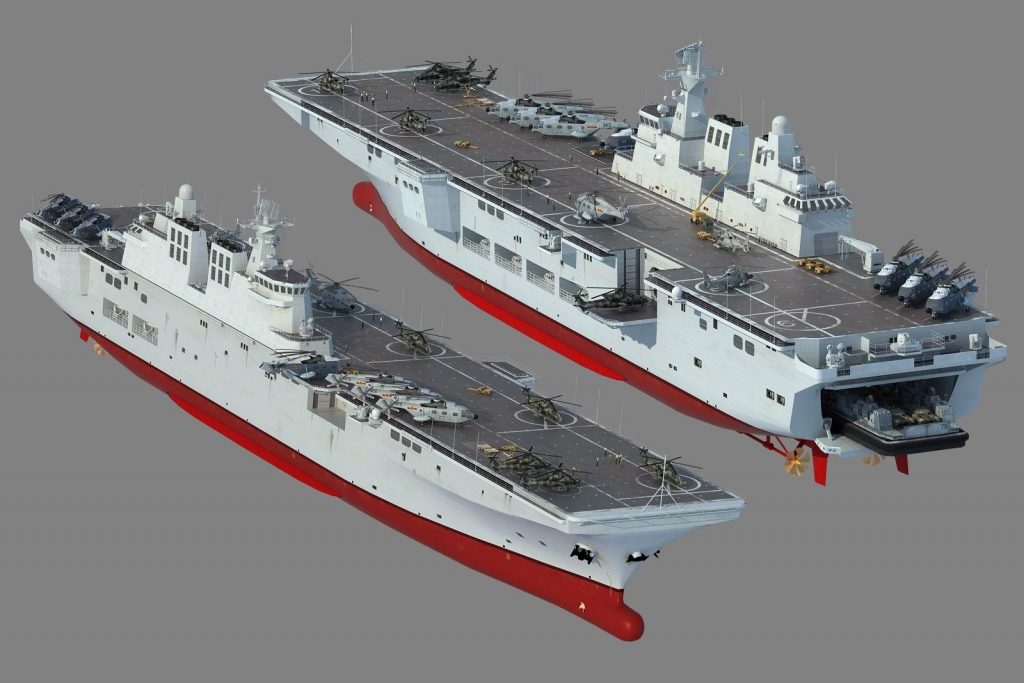



Don´t forget the Railroad!
We have a regular connection Yiwu—Madrid by train. Its only for goods , not for passengers , but it is a start.
http://www.elperiodico.com/es/graficos/sociedad/tren-mas-largo-china-espana-7438/
13052 km long ! Gauge change 3 times
If you are living in Taiwan, I would suggest leaving as soon as possible cause they are gonna come for you first.
^.^
maybe in 2089
Good article and overview. China has outclassed the US in every conceivable area and will replace the US in this 21st Century as the world’s super – power. The US will come to realise how it has been systematically “white ant” subverted by the establishment of the parasitic Fed banking super scam and, moreover, its economy and future utterly subverted by the Zionist International Bankster Cartel headed up by the Rothschilds, Warburgs, Morgans, Rockefellers and their revoltingly greedy and power mad ilk. Now the future for the US looks dark indeed – unless its people revolt against its evil puppeteer controllers of the so called “Deep State”, who are all operatives of the Bankster – Corporatist Cabal of Globalists, seeking to take over and control the planet and make us all serfs to their Matrix of Control. Those who they have no use for they will systematically kill either by warfare, pandemics, disease, drugs or starvation.
China has outclassed the US in every conceivable area and will replace
the US in this 21st Century as the world’s super – power.
not the number of ships is importantn. the quality and experience level of crew is much, much more importatnt. this chinese way is similar like germans before ww1 and ww2. and the brits easily and quickly destroyed their ships.
chinese navy has no chance against japenese or south korean navy. us navy is classes above chinese and will be also in future. the amricans mav the most experiences in battles.
Oh no – not you again! I don’t argue with idiots as they drag you down to their level and then beat you with experience!
what is wrong with you? the truth is that china has no experience with navy. and without big wars it will be also in future. do you want wars???
And how did the US navy use their navy in modern naval battles with a peer? How do you know how well the Ageis and the standard missile defenses work? Last time US fought a peer enemy was the Japanese navy in the battle of Midway in WW2. They got lucky, the Japanese should have won that battle. US naval experience = their ground war experience against a peer enemy…….which equals zero.
usa always used the navy.
and jesus, you son of lucifer, usa won the sea battlas against japan.
talk us about russian experiences. afghanistan, 1st chechen war, cuban crize, lose of ussr. tell us, why is russia trembling at idea to send troops in syria? the afghan syndrome is until otday in blood. americans after vietnam had no fear to send soldiers, if necessary.
you should focus on your problems and not false the history. one thinh is not to like american policy, quite another to be stupid and lie about reality.
stalin did this, he paid with almost 30 000 000 lives. chrushchev did this and left cuba with tail between legs. brezhnev did this and lost war in afghanistan. gorbi did this and lost ussr and cold war.
you are simply not able tolearn form your mistakes. americans were. and LASO NOW, the little putin is modernizing the russian army by copying of americans. :P
Jesus is the son of God, you little ignoramous, there is no false history in what I say, instead of making idiotic statements why don’t you study the battle of Midway and get acquainted with it and make an intelligent response.
So US wants to send troops in Syria, let them come and find out what war is really like and send thousands of body bags home.
I live in US and I have a very good knowledge of history as it was written decades ago, I do not want to hear ignoramous statements from brainwashed ” heroes”.
You, false jeus are the som of lucifer.
yeah, you are the wiset being :DDDD
Where do you get your knowledge from? The synagogue of Satan liars with forked tongues? Have you tried you really read a record of history …..like encyclopedia Britanica or some other historians from 19th and early 20th century.
you know nothing about history, you are blind. bye, son of lucifer!
Are you high on drugs?
Chinese military now has military advantage over US, Japanese forces in East China Sea.
You are years behind the times my boy.
Check out the American Rand corporation view of their military scoreboards between China and USA recently.
dreamer, dreamer are you
How do you explain USS Fitzgerald being hit by medium sized container ship near Yokohama? That looks like an accident due to having a badly trained crew.
Since I read Gavin Menzies and checked out 2 of his critics, one made incorrect conclusions due to not having read the passage he was discussing, and the other stated that, if I remember correctly a sailor by the name of Mar Hue who was in the same 1434 fleet as Zheng He and recorded the event, I read his work and the details were the same as Zheng He’s except his ship sailed up the Red Sea and stopped there, he didn’t transit the Red Sea-Nile Canal, out of over 1000 Ships very few did, so it obviously was not important to the author, and the other thing is all roads led to Florence at the time, why would you commit to such a great game changing project just to visit the ancient Pharoahs ??.
I believed at the time that Allah had moved the Centre of Civilization from China to the ME to allow the outcome of (P) Abraham’s Religion to prevail, in which case, Allah being just will move it back again.